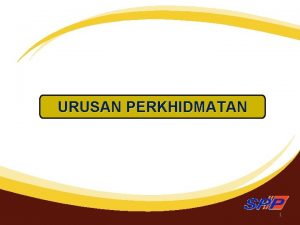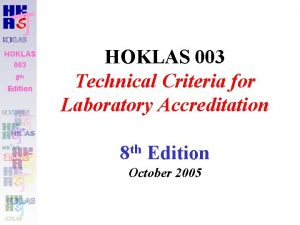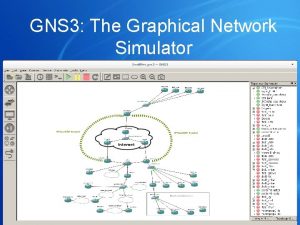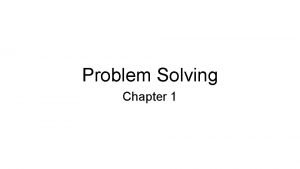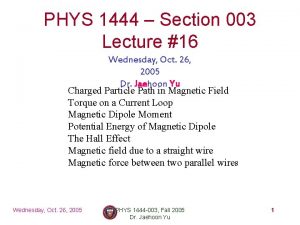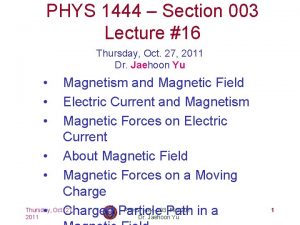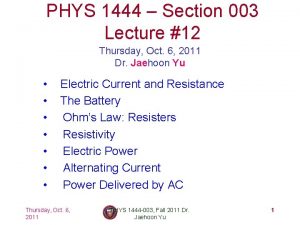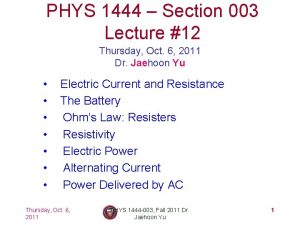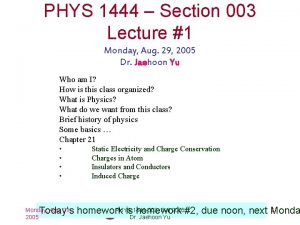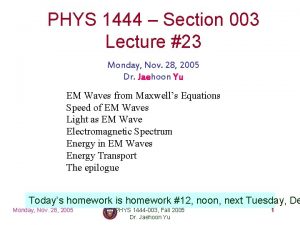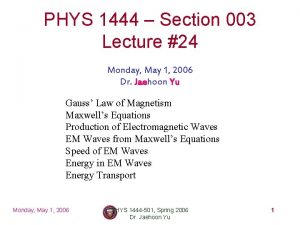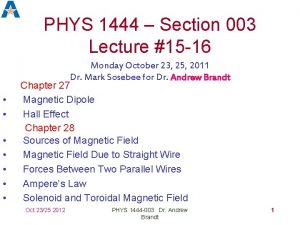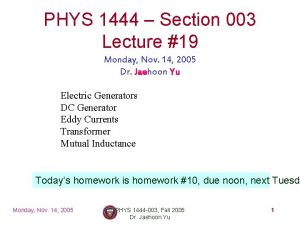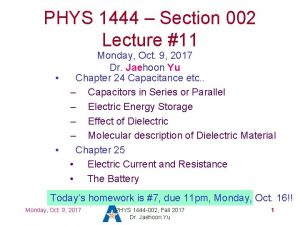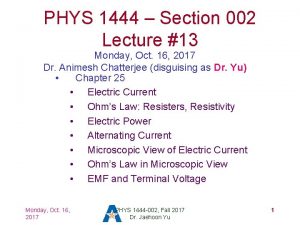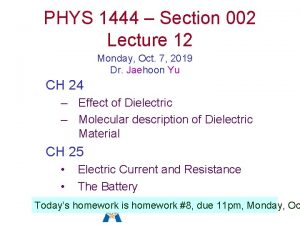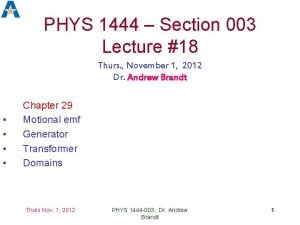PHYS 1444 Section 003 Lecture 17 Monday Oct

















- Slides: 17

PHYS 1444 – Section 003 Lecture #17 Monday, Oct. 31, 2005 Dr. Jaehoon Yu Example for Magnetic force between two parallel wires Ampére’s Law Solenoid and Toroid Magnetic Field Biot-Savart Law Today’s homework is homework #9, due noon, next Thursda Monday, Oct. 31, 2005 PHYS 1444 -003, Fall 2005 Dr. Jaehoon Yu 1

Announcements • Reading assignments – CH 28 – 7, 28 – 8, and 28 – 10 • The 2 nd term exam – – Date: Monday, Nov. 7 Time: 1 – 2: 20 pm Location: SH 103 Coverage: CH 26 – whichever chapter we get to by Wednesday, Nov. 2 • Your textbooks – UTA bookstore agreed to exchange your books with the ones that has complete chapters • You need to provide a proof of purchase – Receipts, copy of cancelled checks, credit card statement, etc. Monday, Oct. 31, 2005 PHYS 1444 -003, Fall 2005 Dr. Jaehoon Yu 2

Example 28 – 2 Suspending a current with a current. A horizontal wire carries a current I 1=80 A dc. A second parallel wire 20 cm below it must carry how much current I 2 so that it doesn’t fall due to the gravity? The lower has a mass of 0. 12 g per meter length. is the gravitational Downward Whichofdirection force? This force must be balanced by the magnetic force exerted on the wire by the first wire. Solving for I 2 Monday, Oct. 31, 2005 PHYS 1444 -003, Fall 2005 Which direction should the The same direction Dr. Jaehoon Yu 3

Operational Definition of Ampere and Coulomb • The permeability of free space is defined to be exactly • The unit of current, ampere, is defined using the definition of the force between two wires each carrying 1 A of current and separated by 1 m – So 1 A is defined as: the current flowing each of two long parallel conductors 1 m apart, which results in a force of exactly 2 x 10 -7 N/m. • Coulomb is then defined as exactly 1 C=1 A. s. Monday, do Oct. it 31, this 2005 way PHYS 1444 -003, Fall 2005 is measured more 4 • We since current Dr. Jaehoon Yu

Ampére’s Law • What is the relationship between magnetic field strength and the current? – Does this work in all cases? • Nope! • OK, then when? • Only valid for a long straight wire • Then what would be the more generalized relationship between the current and the magnetic field for any shape of the wire? – French scientist André Marie Ampére proposed such a relationship soon after Oersted’s Monday, Oct. 31, 2005 PHYS 1444 -003, Fall 2005 5 discovery Dr. Jaehoon Yu

Ampére’s Law • Let’s consider an arbitrary closed path around the current as shown in the figure. – Let’s split this path with small – The sum ofeach all the products segments of Dl long. of the length of each segment and the component of B parallel to that segment is equal to m 0 times the net current Iencl that passes through the surface enclosed by the path – Looks very similar to a – In the limit Dl 0, this relation becomes Ampére’s – Oct. 31, 2005 Monday, Law PHYS 1444 -003, Fall 2005 Dr. Jaehoon Yu law in the electricity. Which law is it? 6 Gauss’

Verification of Ampére’s Law • Let’s find the magnitude of B at a distance r away from a long straight wire w/ current I – This is a verification of Ampere’s Law – We can apply Ampere’s law to a circular path of radius r. Solving for B – We just verified that Ampere’s law works in a simple case – Experiments verified that it works for other Monday, Oct. 31, 2005 PHYS 1444 -003, Fall 2005 7 cases too Dr. Jaehoon Yu

Verification of Ampére’s Law • Since Ampere’s law is valid in general, B in Ampere’s law is not just due to the current Iencl. • B is the field at each point in space along the chosen path due to all sources – Including the current I enclosed by the path but also due to any other sources – How do you obtain B in the figure at any point? • Vector sum of the field by the two currents – The result of the closed path integral in Ampere’s law for green dashed path is still m 0 I 1. Why? – While B in each point along the path varies, the integral over the closed path still comes out the same whethere is the second wire or not. Monday, Oct. 31, 2005 PHYS 1444 -003, Fall 2005 Dr. Jaehoon Yu 8

Example 28 – 4 Field inside and outside a wire. A long straight cylindrical wire conductor of radius R carries a current I of uniform current density in the conductor. Determine the magnetic field at (a) points outside the conductor (r>R) and (b) points inside the conductor (r<R). Assume that r, the radial distance from the axis, is much less than the length of the wire. (c) If R=2. 0 mm and is I=60 A, is Band at r=1. 0 mm, Since the wire long, what straight symmetric, the field should be the same any point the same distance from the center of r=2. 0 mm andatr=3. 0 mm? the wire. Since B must be tangent to circles around the wire, let’s choose a circular path of closed-path integral outside the wire (r>R). What is Iencl? So using Ampere’s law Solving for B Monday, Oct. 31, 2005 PHYS 1444 -003, Fall 2005 Dr. Jaehoon Yu 9

Example 28 – 4 For r<R, the current inside the closed path is less than I. How much is it? So using Ampere’s law Solving for B What does this mean? The field is 0 at r=0 and increases linearly as a function of the distance from the center of the wire up to r=R then decreases as 1/r beyond the radius of the conductor. Monday, Oct. 31, 2005 PHYS 1444 -003, Fall 2005 Dr. Jaehoon Yu 10

Example 28 – 5 Coaxial cable. A coaxial cable is a single wire surrounded by a cylindrical metallic braid, as shown in the figure. The two conductors are separated by an insulator. The central wire carries current to the other end of the cable, and the outer braid carries the return current and is usually considered ground. Describe the magnetic field (a) in the space between the conductors and (b) outside the cable. the conductors (a) The magnetic field between is the same as the long, straight wire case since the current in the outer conductor does not impact the enclosed current. (b) Outside the cable, we can draw a similar circular path, since we expect the field to have a circular symmetry. What is the sum of the total current inside the closed path? So there is no magnetic field outside a coaxial cable. In other words, the coaxial cable self-shields. The outer conductor also shields against an external electric field. Monday, Oct. 31, 2005 PHYS 1444 -003, Fall 2005 11 Cleaner signal and less noise. Dr. Jaehoon Yu

Solenoid and Its Magnetic Field • What is a solenoid? – A long coil of wire consisting of many loops – If the space between loops are wide • The field near the wires are nearly circular • Between any two wires the fields due to each loop cancel • Toward the center of the solenoid, the fields add up to give a field that can be fairly large and uniform – For a long, densely packed loops • The field is nearly uniform and parallel to the solenoid axes within the entire cross section • The field outside the solenoid is very small compared to the field inside, except the ends – The same number of field lines spread out to an open Monday, Oct. space 31, 2005 PHYS 1444 -003, Fall 2005 Dr. Jaehoon Yu 12

Solenoid Magnetic Field • Now let’s use Ampere’s law to determine the magnetic field inside a very long, densely packed solenoid • Let’s choose the path abcd, far away from the ends – We can consider four segments of the loop for integral – – The field outside the solenoid is negligible. So the Monday, integral Oct. 31, 2005 on a b. PHYS 1444 -003, Fall 2005 13 is Dr. 0. Jaehoon Yu

Solenoid Magnetic Field – So the sum becomes: – If a current I flows in the wire of the solenoid, the total current enclosed by the closed path is NI • Where N is the number of loops (or turns of the coil) enclosed – Thus Ampere’s law gives us – If we let n=N/l be the number of loops per unit length, the magnitude of the magnetic field within the solenoid becomes – • B depends on the number of loops per unit length, n, and the current Monday, Oct. 31, 2005 PHYS 1444 -003, Fall 2005 14 • But does not depend on the position within the Dr. Jaehoon Yu

Example 28 – 8 Toroid. Use Ampere’s law to determine the magnetic field (a) inside and (b) outside a toroid, which is like a solenoid bent into the shape a you circle. (a) Howofdo think the magnetic field lines inside the toroid Sincelook? it is a bent solenoid, it should be a circle concentric with toroid. path of integration one of these field lines of If wethe choose radius r inside the toroid, path 1, to use the symmetry of the situation, making B the same at all points on the path. So from Ampere’s law Solving for B So the magnetic field inside a toroid is not uniform. It is larger on the inner edge. However, the field will be uniform if the radius is large and the toroid is thin and B = m 0 n. I. (b) Outside the solenoid, the field is 0 since the net enclosed Monday, Oct. PHYS 1444 -003, Fall 2005 15 current is 31, 0. 2005 Dr. Jaehoon Yu

Biot-Savart Law • Ampere’s law is useful in determining magnetic field utilizing symmetry • But sometimes it is useful to have another method of using infinitesimal current segments for B field – Jean Baptiste Biot and Feilx Savart developed a law that a current I flowing in any path can be considered as many infinitesimal current elements – The infinitesimal magnetic field d. B caused by the infinitesimal length dl that carries current I is Biot-Savart – Law • r is the displacement vector from the element dl to the point P • Biot-Savart Monday, Oct. 31, 2005 law is the magnetic equivalent Coulomb’s PHYS 1444 -003, Fall 2005 B field in Biot-Savart law is only that by to the current law 16 Dr. Jaehoon Yu nothing else.

Example 28 – 9 B due to current I in straight wire. For the field near a long straight wire carrying a current I, show that the Biot-Savarat law gives the same result as the simple long straight wire, is B=m 0 I/2 p. R. What the direction of the field B at Going into the point page. on right-hand All d. BP? at point P has the same direction based rule. The magnitude of B using Biot-Savart law is Where dy=dl and r 2=R 2+y 2 and since we obtain Integral becomes Monday, Oct. 31, 2005 1444 -003, Fall 2005 The same as the. PHYS simple, long straight wire!! It Dr. Jaehoon Yu 17
 Asia 1444
Asia 1444 Basic electricity and optics
Basic electricity and optics 01:640:244 lecture notes - lecture 15: plat, idah, farad
01:640:244 lecture notes - lecture 15: plat, idah, farad Jadual kenaikan gaji tahunan
Jadual kenaikan gaji tahunan 0031 prefijo
0031 prefijo Norme nbn d 51-003
Norme nbn d 51-003 Hoklas 003
Hoklas 003 Gns cisco
Gns cisco Explain why the bagged and loose toothpicks
Explain why the bagged and loose toothpicks Nbn d 51-003
Nbn d 51-003 Ixos viewer
Ixos viewer Hltaid 003
Hltaid 003 001 002 003
001 002 003 Nbn 51-003
Nbn 51-003 Sol 003
Sol 003 Ikjeft
Ikjeft Hoklas 003
Hoklas 003 001 002 003
001 002 003



